SRS side airbag and SRS curtain airbag
The SRS side airbag is stored in the door side of each front seat seatback, which bears an “SRS AIRBAG” label.
In a moderate to severe side impact collision, the SRS side airbag on the impacted side of the vehicle deploys between the occupant and the door panel and supplements the seatbelt by reducing the impact to the occupant’s chest and waist. The SRS side airbag operates only for front seat occupants.
The SRS curtain airbag on each side of the cabin is stored in the roof side (between the front pillar and a point over the second-row seat). An “SRS AIRBAG” mark is located at the top of each center pillar.
In a moderate to severe side impact collision, the SRS curtain airbag on the impacted side of the vehicle deploys between the occupant and the side window and supplements the seatbelt by reducing the impact on the occupant’s head.
In a rollover, SRS curtain airbags on both sides of the vehicle deploy between the occupant and the side window and sup plement the seatbelt by reducing the impact to the occupant’s head.
The SRS curtain airbag does not operate for third-row seat occupants.
WARNING
The SRS side airbag and SRS curtain airbag are designed as only a supplement to the primary protection provided by the seatbelt. They do not do away with the need to fasten seatbelts. It is also important to wear your seatbelt to help avoid injuries that can result when an occupant is not seated in a proper upright position.
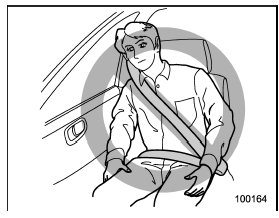
WARNING
• Do not sit or lean unnecessarily close to either front door. The SRS side airbag is stored in both front seat seatbacks next to the door, and it provides protection by deploying rapidly (faster than the blink of an eye) in the event of a side impact collision. However, the force of SRS side airbag deployment may cause injuries if your head or other parts of the body are too close to the SRS side airbag.
• Since your vehicle is equipped with SRS curtain airbags, do not sit or lean unnecessarily close to the front or rear door on either side. Also, do not put your head, arms and hands out of the window.
The SRS curtain airbag on each side of the cabin is stored in the roof side (between the front pillar and a point over the second- row seat), and it provides protection by deploying rapidly (faster than the blink of an eye) in the event of a side impact or a rollover. However, the force of its deployment may cause injuries if your head is too close to it.
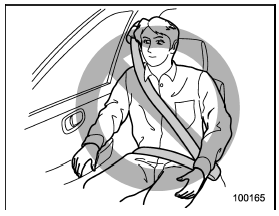
WARNING
Do not rest your arm on either front door or its internal trim. It could be injured in the event of SRS side airbag deployment.
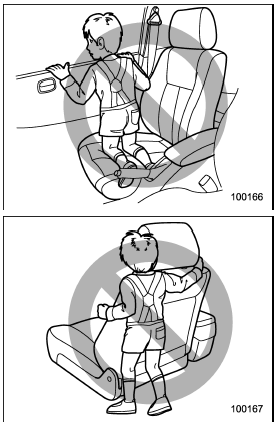
WARNING
• Never allow a child to kneel on the front passenger’s seat facing the side window or wrap his/her arms around the front seat seatback.
In the event of an accident, the force of the SRS side airbag deployment could injure the child seriously because his/her head or arms or other parts of the body are too close to the SRS side airbag.
Since your vehicle is also equipped with a front passenger’s SRS frontal airbag, children aged 12 and under should be placed in a rear seat anyway and should be properly restrained at all times.
• Never allow a child to kneel on any passenger’s seat facing the side window or put their head, arms or hands out of the window.
In the event of an accident, the force of the SRS curtain airbag deployment could injure the child seriously because his/her head is close to the SRS curtain airbag.
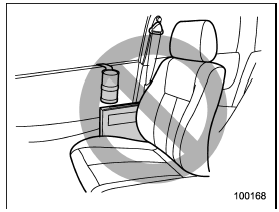
WARNING
• Do not attach accessories to the door trim or near either SRS side airbags and do not place objects near the SRS side airbags. In the event of the SRS side airbag deployment, they could be propelled dangerously toward the vehicle’s occupants and cause injuries.
• Do not attach a hands-free microphone or any other accessory to a front pillar, a center pillar, a rear pillar, the windshield, a side window, an assist grip, or any other cabin surface that would be near a deploying SRS curtain airbag.
A hands-free microphone or other accessory in such a location could be propelled through the cabin with great force by the curtain airbag, or it could prevent correct deployment of the curtain airbag. In either case, the result could be serious injuries.
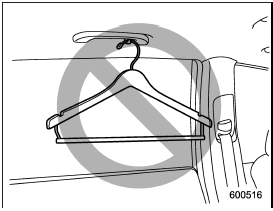
WARNING
Do not hang coat hangers or other hard or pointed objects on the coat hooks. If such items were hanging on the coat hooks during deployment of the SRS curtain airbags, they could cause serious injuries by coming off the coat hooks and being thrown through the cabin or by preventing deployment of the curtain airbags.
Before hanging clothing on the coat hooks, make sure there are no sharp objects in the pockets. Hang clothing directly on the coat hooks without using hangers.
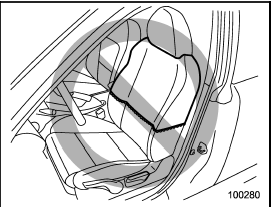
WARNING
Do not put any kind of cover or clothes or other objects over either front seatback and do not attach labels or stickers to the front seat surface on or near the SRS side airbag. They could prevent proper deployment of the SRS side airbag, reducing protection available to the front seat’s occupant.
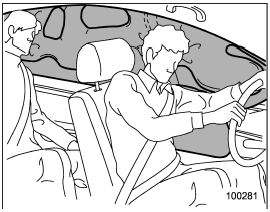
The SRS side airbag and SRS curtain airbag can function only when the ignition switch is in the “ON” position.
The driver’s and front passenger’s SRS side airbags and SRS curtain airbags deploy independently of each other because each has its own impact sensor.
Therefore, they may not both deploy in the same accident. Also, the SRS side airbag and SRS curtain airbag deploys independently of the driver’s and front passenger’s SRS frontal airbags in the steering wheel and instrument panel.
An impact sensor, which senses impact force, is located in each of the left and right center pillars and rear wheel houses.
Another impact sensor, which also senses impact force, is located under the secondrow center seat. In addition, a rollover sensor is located inside the airbag control module.
If one of the center pillar impact sensors and the impact sensor that is located under the second-row center seat together sense an impact force above a predetermined level in a side collision, the control module causes both the SRS side airbag and curtain airbag on the impacted side to inflate regardless of whether the rear wheel house impact sensor on the same side senses an impact. At this time, the driver’s and front passenger’s seatbelt pretensioners also operate at the same time.
If one of the rear wheel house impact sensors and the impact sensor that is located under the second-row center seat together sense an impact force above a predetermined level in a side collision, the control module causes only the SRS curtain airbag on the impacted side to inflate.
If the rollover sensor detects rollover of the vehicle, the control module inflates the SRS curtain airbags. At this time, the driver’s and front passenger’s seatbelt pretensioners also operate at the same time.
After deployment, the SRS side airbag immediately starts to deflate. The time required from detection of an impact to deflation of an SRS side airbag after deployment is shorter than the blink of an eye.
The SRS curtain airbag remains inflated for a while following deployment then slowly deflates.
The SRS side airbag and SRS curtain airbag deploy even when no one occupies the seat on the side on which an impact is applied.
When the SRS side airbag and SRS curtain airbag deploy, a sudden, fairly loud inflation noise will be heard and some smoke will be released. These occurrences are a normal result of the deployment.
This smoke does not indicate a fire in the vehicle.
CAUTION
Do not touch the SRS side airbag system components around the front seat seatback with bare hands right after deployment. Doing so can cause burns because the components can be very hot as a result of deployment.
After deployment, do not touch any part of the SRS curtain airbag system (from the front pillar to the part of the roof side over the second-row seat). Doing so can cause burns because the components can be very hot as a result of deployment.
The SRS side airbag and SRS curtain airbag are designed to deploy in the event of an accident involving a moderate to severe side impact collision. Also, in the case of a rollover, the SRS curtain airbag deploys. They are not designed to deploy in most lesser side impacts. Also, they are not designed to deploy in most frontal or most rear impacts because SRS side airbag and SRS curtain airbag deployment would not help the occupant in those situations.
Each SRS side airbag and SRS curtain airbag are designed to function on a onetime- only basis.
SRS side airbag and SRS curtain airbag deployments depend on the level of force experienced in the passenger compartment during a side impact collision. That level differs from one type of collision to another, and it may have no bearing on the visible damage done to the vehicle itself. Also, the SRS curtain airbag deploys depending on the vehicle’s position and inclination at the time of the rollover.
▲ Example of the type of accident in which the SRS side airbag will most likely deploy
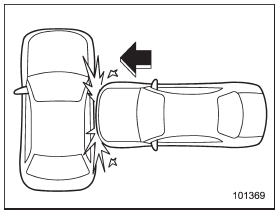
A severe side impact near the front seat activates the SRS side airbag.
!Examples of the types of accidents in which the SRS curtain airbag will most likely deploy
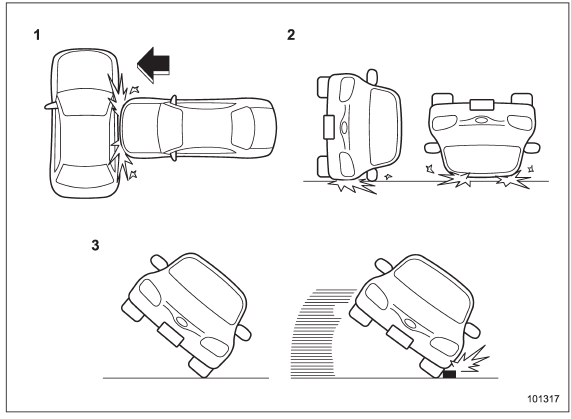
1) A severe side impact near the front seat or the second-row seat activates the SRS curtain airbag.
2) The vehicle rolls onto its side or the roof.
3) If the angle of vehicle tip-up is marginal or if the skidding vehicle’s tires hit a curbstone laterally.
▲ Examples of the types of accidents in which it is possible that the SRS side airbag and the SRS curtain airbag will deploy
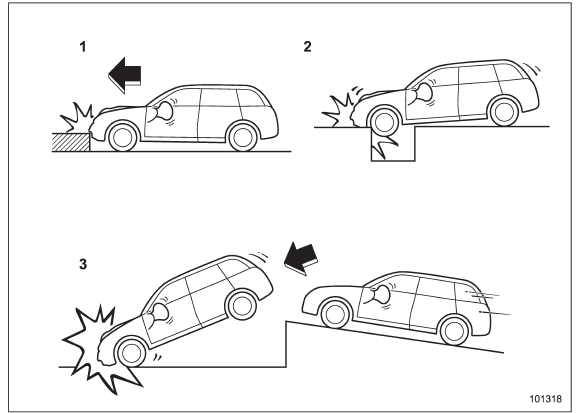
1) Hitting a curb, edge of pavement or hard
surface
2) Falling into or jumping over a deep hole
3) Landing hard or vehicle falling
It is possible that the SRS side and curtain airbags will deploy if a serious impact occurs to the underside of your vehicle.
Some examples are shown in the illustration.
▲ Examples of the types of accidents in which the SRS side airbag is unlikely to deploy
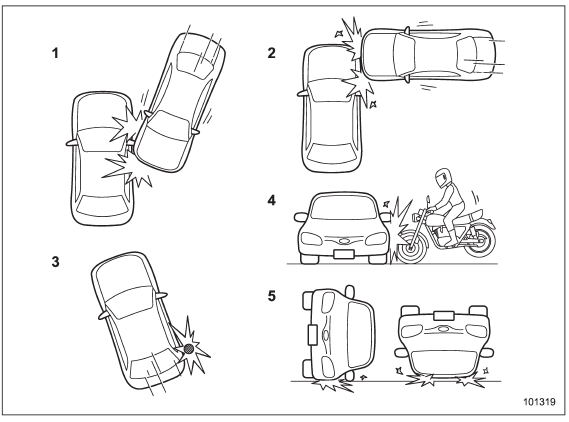
1) The vehicle is involved in an oblique side-on impact.
2) The vehicle is involved in a side-on impact in an area outside the vicinity of the passenger compartment.
3) The vehicle strikes a telephone pole or similar object.
4) The vehicle is involved in a side-on impact from a motorcycle.
5) The vehicle rolls onto its side or the roof.
There are many types of collisions which might not necessarily require SRS side airbag deployment. In the event of accidents like those illustrated, the SRS side airbag may not deploy depending on the level of accident forces involved.
▲ Examples of the types of accidents in which the SRS curtain airbag is unlikely to deploy
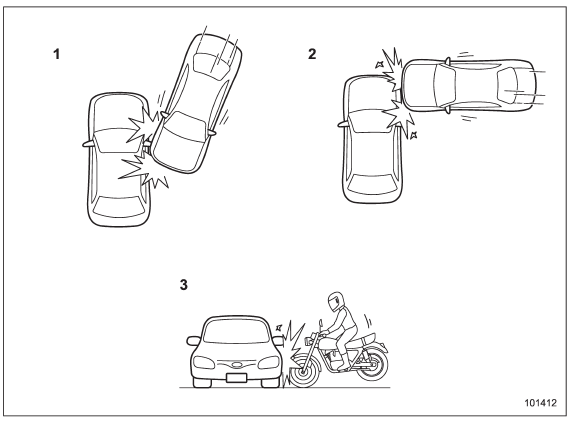
1) The vehicle is involved in an oblique side-on impact.
2) The vehicle is involved in a side-on impact in an area outside the vicinity of the passenger compartment.
3) The vehicle is involved in a side-on impact from a motorcycle.
There are many types of collisions which might not necessarily require SRS curtain airbag deployment. In the event of accidents like those illustrated, the SRS curtain airbag may not deploy depending on the level of accident forces involved.
▲ Examples of the types of accidents in which the SRS side airbag and SRS curtain airbag are not designed to deploy in most cases
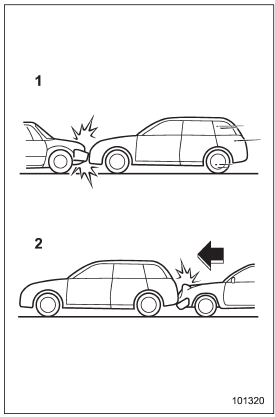
1) The vehicle is involved in frontal collision with another vehicle (moving or stationary).
2) The vehicle is struck from behind.
The SRS side airbag and SRS curtain airbag are not designed to deploy in most cases if the vehicle is involved in a frontal collision or is struck from behind. Examples of such accidents are illustrated.
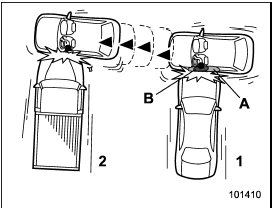
1) First impact
2) Second impact
A) SRS curtain airbag
B) SRS side airbag
In an accident where the vehicle is struck from the side more than once, the SRS side airbag and SRS curtain airbag deploy only once on the first impact.
Example: In the case of a double side impact collision, first with one vehicle and immediately followed by another from the same direction, once the SRS side airbag and SRS curtain airbag are activated on the first impact, they will not be activated on the second.
▲ Example of the type of accident in which the SRS curtain airbag is not designed to deploy in most cases
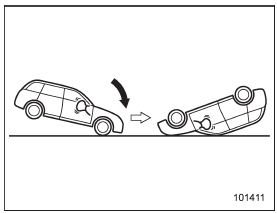
The SRS curtain airbags are not designed to deploy in most cases if the vehicle pitches end over end.
